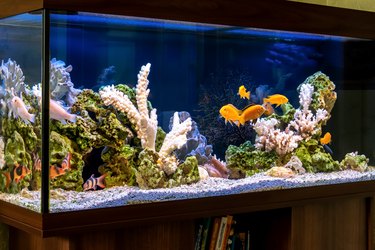
Cleaning your fish tank gravel with a vacuum made specifically for the fish tank is the easiest method of cleaning. Fish tank vacuums are designed to quickly and easily remove bits of uneaten food and other waste that settles to the bottom of the tank. However, a fish tank gravel vacuum isn't the only alternative.
First, pull your fish out
Video of the Day
Although you don't have to remove your fish from the tank when you use an aquarium gravel vacuum, you'll want to remove them when cleaning the fish tank without a siphon. When you clean your fish tank gravel without a vacuum, it will stir up silt and detritus, which can be unhealthy for them to ingest.
Video of the Day
Fill a bucket or other clean container with water from your aquarium and gently transfer fish to the bucket using a net. Make sure the bucket is very clean, as even minute traces of chemical residue can harm fish, according to Fish Tank Club. A bucket or container that has been dedicated exclusively for use by your fish since it was new is the safest option.
Remove the gravel
Scoop up a couple of cupfuls of the gravel from the bottom of the tank and set aside without rinsing. This gravel contains beneficial bacteria that help break down ammonia from fish waste into less harmful nitrates. It's important to keep some gravel uncleaned so these bacteria can repopulate easily after your tank is cleaned.
Place the remaining gravel into a sieve and rinse thoroughly beneath running water, stirring it around with a plastic-gloved hand. Make sure the gloves, strainer and any other tools and utensils you use are dedicated exclusively for use with your fish to ensure that no chemical residue will get transferred.
Once the water beneath the strainer runs clear, return the gravel to the tank. Add the cups of dirty gravel that you set aside and mix thoroughly with the clean gravel. This method is the most effective if you have algae growing in your substrate, according to Fish Tank Master.
Try an alternate method
Caring Pets suggests a second method of cleaning aquarium gravel without a filter that doesn't require removing the gravel at all. This method is ideal if you have live plants, as taking them out of the aquarium can damage the roots and ultimately kill the plants.
First, remove your fish from the tank, along with any decorations. Keep your live plants rooted in the gravel, and if necessary, slide the plant and its surrounding gravel to one side of the aquarium.
Stir up the gravel with your hand, working around the live plants. Thoroughly mix up the gravel so detritus trapped between the stones is suspended in the water. Next, dip out one-third to one-half of the silty water left in the tank. The remaining water contains the healthy bacteria needed to repopulate your tank.
Say hello to your little friends
Algae eaters and snails can also help clean your gravel. The best varieties for cleaning your aquarium gravel are those that love to burrow beneath the substrate.
Malaysian trumpet snails are detrivores — meaning that they'll devour both plant matter and protein they find in the gravel. However, these busy snails won't devour your plants and, in fact, help them by aerating the roots, according to Nualgia Aquarium.
Most other algae-eating creatures don't burrow, per se. And not all will eat plant matter, algae, and leftover fish food. You must also consider whether the algae eaters you choose will get picked on by larger tank mates. Cherry shrimp, for example, are good for cleaning up all kinds of detritus, but larger tank mates will hunt and eat them.
Siamese algae eaters are another wise addition. Besides eating all types of algae, they help control flatworms and suck up just about any kind of waste with a ravenous appetite.